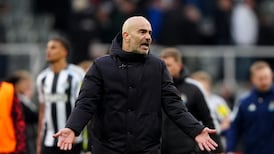On Tennis: The Davis Cup is a mishmash of a competition. But at international level, it's the only thing Ireland have, and for that reason it's uniquely useful in allowing up-and-coming Irish players the experience of meeting elite opponents who have played at Grand Slam level.
Ireland's last experience, for instance, against Finland, brought Louk and Kevin Sorensen, David O'Connell and Triston Farron-Mahon into contact with Finland's best player, Jarkko Nieminen. Nieminen, made it to the recent quarter-finals at Wimbledon before going out in three sets to the eventual runner-up, Rafael Nadal. It is unlikely any of the Irish team would have faced a player of his stature other than in the Davis Cup.
While Ireland were soundly beaten 3-2 in that match against the Finns and now slide toward relegation before their Europe/African Zone Group Two game against Slovenia in Fitzwilliam on July 21st, 22nd and 23rd, a number of people will say to themselves, "Well yes, I know Davis Cup is international tennis but what exactly is at stake here?"
The competition can be confusing, because, often, people that are interested in tennis and read about the Davis Cup don't understand the structures, and when experienced players such as Conor Niland and Peter Clarke are not involved, casual followers wonder why not.
Top players have long promoted Davis Cup tennis, high-profile personalities such as Goran Ivanisevic and John McEnroe enthusiastically waving their national flags for the competition.
In 2005 Ivanisevic, Mario Ancic, Ivan Ljubicic and Ivo Karlovic won the cup for the first time for Croatia, a piece of tennis trivia not so many people know.
But when McEnroe was captain of the US team, he sometimes found it difficult to get the best of his compatriots to line up, Pete Sampras and Andre Agassi both ducking out if it didn't suit their tour schedules.
As it stands, the lesser nations in the competition rarely get the chance to play against the Nieminens, Ivanisevices, Roger Federers, Nadals and Andy Roddicks of this world because the structures tend to keep the stronger nations such as America, Russia, Spain, Australia and France in the elite 16-nation World Group (division one) of the competition.
The 2006 official guide to professional tennis ostentatiously lists the winners of the World Group but does not bother giving the results of the other groups.
"At the levels below the World Group, the Davis Cup nations compete in zonal competitions, which are split into three zones: the Americas Zone, the Asia/Oceania Zone and the Europe/Africa Zone. In each zone there are four groups, Group I being the highest and Group IV the lowest. Groups I and II operate on a home-and-away knockout basis in all three zones.
"The exact format and draw size varies from group to group and zone to zone, but essentially, winning nations advance until one or more nations are (sic) promoted to Group I from Group II, and to the World Group play-off ties from Group I."
That explanation by the official site seems clear enough, what? The International Tennis Federation will argue they have 133 competing nations, all at different levels and all operating within different budgets.
We say they don't really care about an African Group Five zone, but if the US fell out of the top group and stayed out for a number of years you would hear terrible mutterings rumbling around the tennis world.
More recently the competition made it into the news because the world's most populous Muslim nation, Indonesia, withdrew from their game against Israel because of the Israeli military offensive in the Gaza Strip.
Still, it's important for Ireland to win the match and the players to be supported and not slide further back. The recent Futures events in Limerick and Dublin and the Shelbourne Irish Open Challenger event in Fitzwilliam were convenient vehicles for Irish players who might not have had the chance to compete three weeks in a row had Ireland not hosted those competitions.
While media exposure may have suffered in the context of the rather larger event at Wimbledon, it has been a good month or so for Irish tennis, if not for the Irish players involved, who were unable to generate a run deep into the draws.
Captained by the non-playing Owen Casey, the team to face Slovenia is the same that met Finland. And who knows - if Ireland stay up and Britain get relegated from the group above, maybe then we will see a little more passion all round about the Davis Cup.
French Open champion Rafael Nadal escaped unhurt after the car in which he was travelling hit an electricity pylon on Mallorca, Spanish media reported yesterday. The 20-year-old world number two returned to his home town on the island on Monday after losing to Switzerland's Roger Federer in the singles final at Wimbledon.
Spanish news agency Europa Press reported a woman living nearby went to investigate after hearing the crash and found Nadal dazed but unhurt.












